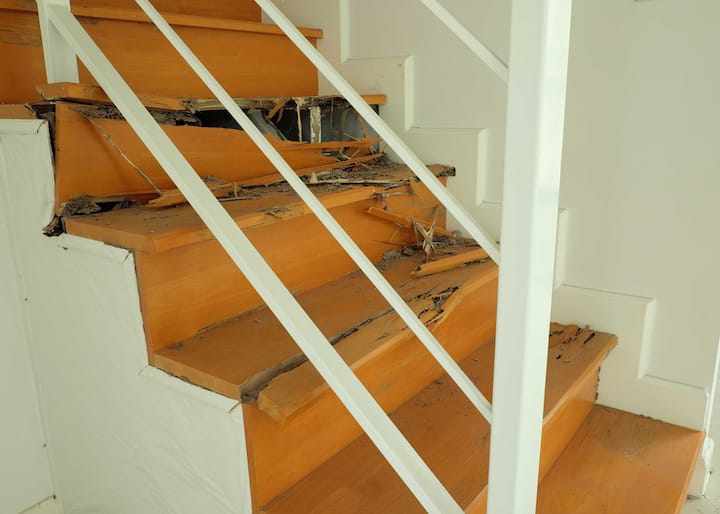Specialized experts in termite removal in Merced
The Hidden Perils of Termites: Protect Your Home and Health
Termites, the insidious foes of homeowners, lurk beneath the surface, wreaking havoc on the foundation of our homes. As silent destroyers, they feed on the cellulose in wood, leaving behind a trail of destruction that can compromise the integrity of a structure and pose severe health risks.
The Harbingers of Destruction: Signs of Termite Infestation
Early detection is crucial in preventing catastrophic damage caused by termites. Vigilance is key in identifying their presence before significant harm occurs. Here are telltale signs that should raise the alarm:
- Mud Tubes: These pencil-thin, earthen tunnels serve as pathways for termites to travel from their nests to food sources. Their presence on walls, floors, or foundations is a clear indication of an infestation.
- Hollow Wood: If you tap on wooden surfaces and hear a hollow sound, it may be a sign that termites have consumed the interior, leaving behind a paper-thin veneer.
- Damaged or Buckled Wood: Warped or sagging wood is another telltale sign of termite activity. As they feed on the cellulose, wood loses its strength and structural integrity.
- Discarded Wings: Swarmer termites shed their wings after mating, leaving behind tiny, translucent wings near window sills or doors.
- Fecal Pellets: Tiny, oval-shaped droppings, known as fecal pellets, are a clear indication of termite presence. You may find them near termite colonies or entry points.
The Health Hazards of Termite Infestation
Beyond the structural damage they cause, termites can also pose significant health risks to occupants:
- Allergic Reactions: Termite droppings and shed skins can trigger allergic reactions, causing respiratory problems such as asthma and chronic coughing.
- Irritated Skin: Contact with termite fecal pellets can cause skin irritation, itching, and redness.
- Contaminated Food: If termites infest food pantries or cupboards, they can contaminate food with their droppings, potentially leading to foodborne illnesses.
Comprehensive Termite Control: A Multi-Faceted Approach
Combating termite infestations requires a comprehensive approach:
- Professional Inspection: The first step is to schedule a professional termite inspection. A qualified exterminator will thoroughly examine your property to identify any signs of infestation and determine the extent of the damage.
- Termite Treatment: If termites are present, there are several effective treatment options available, including chemical barriers, bait stations, and heat treatments. These methods aim to eliminate active infestations and prevent future ones.
- Moisture Control: Termites are drawn to moisture, so it is essential to eliminate any sources that could attract them, such as leaking pipes, clogged gutters, or excessive humidity.
- Regular Monitoring: Once a termite infestation has been eradicated, regular monitoring is crucial to prevent re-infestation. This involves periodic inspections and prompt treatment of any new termite activity.
Protecting Your Home and Health from Termites
- Taking proactive measures can help prevent the devastating effects of termite infestations:
- Inspect Your Property: Regularly check your home for signs of termite activity, especially in areas with high moisture levels.
- Remove Termite Attractants: Keep firewood away from your home and trim bushes and trees that touch the structure.
- Seal Entry Points: Caulk or seal any cracks or gaps in your home’s foundation, walls, and pipes.
- Maintain Dry Conditions: Fix any leaks or water damage and ensure proper ventilation in crawl spaces and basements.
Choose the Trusted Experts in Termite Control
- Partner with a reputable pest control company for comprehensive termite prevention and treatment services. Our team of certified professionals utilizes the latest techniques and products to effectively eliminate termites and protect your home and health. Contact us today to schedule an inspection and safeguard your property from these insidious foes.
- Remember, termites are a serious threat to homes and health. By educating yourself about the signs of infestation and taking the necessary precautions, you can protect your most valuable investment.

Get your fast, local termite control estimate
Protect Your Home from Termites
Termites can silently damage your home, leading to costly repairs. Don’t wait until it’s too late! Contact our network of termite removal experts today to schedule a termite inspection.
Connect with a Local Termite Removal Expert
Our termite removal contractors have years of experience and are highly knowledgeable in identifying and treating termite infestations. You can trust that your home will be in great hands with one of our network professionals.
- Call our team to connect with a termite removal expert
- Complete our estimate form for a callback at your convenience
Don’t Delay: Protect Your Investment
Termites can cause significant damage to your home, leading to expensive repairs. Protect your home and investment by taking the necessary steps to prevent and eliminate termite infestations. Contact our network today and schedule a termite inspection. Our quality service and competitive prices ensure that your home is in good hands.